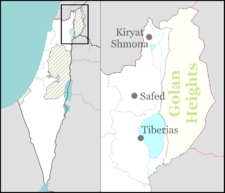The Nazareth Hospital
| The Nazareth Hospital | |
|---|---|
| The Nazareth Trust | |
| Geography | |
| Location | Nazareth, Northern District, Israel |
| Coordinates | 32°42′06″N 35°17′30″E / 32.7017°N 35.2917°ECoordinates: 32°42′06″N 35°17′30″E / 32.7017°N 35.2917°E |
| Organisation | |
| Patron | None |
| Services | |
| Emergency department | Yes |
| Links | |
| Website | www |
The EMMS Nazareth Hospital, also known as Scottish Hospital and English Hospital, is the general hospital of the city of Nazareth, Israel. It was founded as a Christian mission by Dr. Karloost Vartan and the Edinburgh Medical Missionary Society in 1861. The hospital now houses 147 beds, employs over 500 staff, and receives over 50,000 visits annually.
The Nazareth Hospital project was originally led by Dr. Pacradooni Kaloost Vartan. Born in Constantinople to an Armenian family in 1835, he attended an American Protestant School for Armenian Boys. During the Crimean War, he served as an interpreter for British forces. There, he was moved and inspired by the poor conditions of war, and by the care provided at the hospitals run by Florence Nightingale. Vartan moved to Edinburgh, Scotland to study medicine. His studies were funded by the newly founded Edinburgh Medical Missionary Society (EMMS). Established in 1841 by a group of doctors, the EMMS aimed to provide medical services to foreign countries, to "circulate information on medical mission [sic], help other institutions engaged in the same work and assist as many missionary stations as their funds would permit." Dr. Vartan was first funded by the Syrian Asylum Fund in 1861 to aid massacre victims in Beirut. After the Syrian Asylum Committee was dissolved, the EMMS recruited his services for a new mission in Nazareth starting in 1866.
During this time, Palestine was governed by the Ottoman Empire. Lack of adequate social services and environmental factors contributed to poor public health. Citizens suffered from cholera, dysentery, malaria, and tuberculosis, and infant mortality was high. Palestine was en route for those participating in the Hajj, which made locals susceptible to a steady influx of foreign diseases. Traditional medicine included herbal treatments, cauterization, bloodletting, bonesetting, cupping, and leeching, among various tribal rituals. In 1861 the average life expectancy was 22 for males and 24 for females. Although Ottoman law required the provision of medical services, in reality, it did little more than employ a few municipal part-time workers. In the 1860's, Nazareth was home to nearly 5,000 citizens, but the nearest doctor or hospital was as far away as Damascus or Beirut. Ultimately, the only care was provided by charity.
...
Wikipedia

